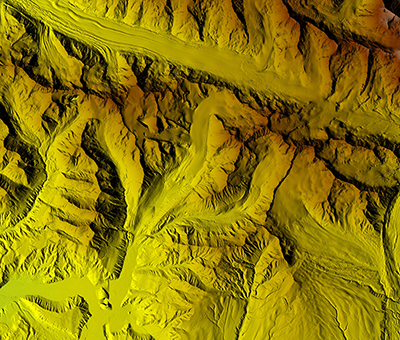
Newly unveiled high-resolution digital topographic maps of Alaska display, more sharply than ever before, the state’s landscape. The images will help with decision making and provide a better understanding of the impact of climate change, according to U.S. government officials.
The unclassified three-dimensional (3-D) digital elevation models (DEMs), which the U.S. National Geospatial-Intelligence Agency (NGA) and the National Science Foundation (NSF) released Thursday, provide at least 2-meter resolution throughout the state. The White House also announced plans to release these sorts of elevation models, at lower resolution, in 2017 for the entire Arctic.
To construct the topographic models, image-processing algorithms convert stereo pairs of 2-meter-resolution imagery, captured by DigitalGlobe commercial satellites, into 3-D imagery, according to NSF. The agency noted that satellites can reimage even remote areas within shorter time intervals and at less cost than aircraft. “In a changing Arctic, [the ability to capture new imagery more frequently] is huge,” said Kelly Falkner, director of NSF’s Division of Polar Programs.
Congressional Thumbs Up
Fabien Laurier, senior policy adviser with the White House Office of Science and Technology Policy, told Eos that the new Alaska models provide 15 times higher resolution than 30-meter-resolution models that, until now, were the best publicly available for the state. By providing 2-meter resolution, he noted, the new models depict Alaska’s terrain about as sharply as 1- to 2-meter-resolution models already available for most U.S. states and much of the industrial world.

That pleases U.S. Sen. Lisa Murkowski (R-Alaska), who told Eos that “Alaska and the Arctic are woefully left behind when it comes to mapping and charting across the board, so any progress is important to ensure the safety and well-being of our state. Although there is still a mountain of work to be done, I applaud the efforts of the NGA and NSF and look forward to their upcoming releases in 2017.”
Game Changers
The models are “game changers,” according to John Farrell, executive director of the U.S. Arctic Research Commission: “They can be used for a whole slew of purposes, from better understanding landscape evolution to just even simple navigation.” The new tools can provide local communities with “science-based actionable knowledge” that could improve their resilience in the face of climate change and its impacts, Laurier added.
The terrain modeling of Alaska and the Arctic is creating an archive of high-resolution imagery of the region at a critical time, said Tom Heinrichs, director of the Geographic Information Network of Alaska at the University of Alaska Fairbanks. “Both the DEM itself and the source stereo pair imagery will be invaluable to future scientists seeking a snapshot of the Arctic during the onset of a period of major global climate change,” he predicted.

According to Laurier, the Arctic-wide models aim to provide at least an 8-meter resolution by the end of the U.S. rotating chairmanship of the Arctic Council in 2017.
A public-private partnership— including NSF, NGA, the University of Minnesota’s Polar Geospatial Center, the U.S. Geological Survey, the Environmental Systems Research Institute, Inc., and others—is carrying out the modeling project in response to a 2015 White House Executive Order on “Enhancing Coordination of National Efforts in the Arctic.”
—Randy Showstack, Staff Writer
